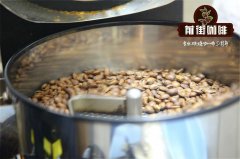Introduction to the flavor characteristics of Ethiopian coffee bean-Harald coffee

Professional coffee knowledge exchange more coffee bean information please follow the coffee workshop (Wechat official account cafe_style)
Ethiopia has always been regarded as the birthplace of coffee. When you understand the local way of handling coffee, you can probably understand that this imperial status is well-deserved. Even under the worst production conditions, coffee trees are blocked by other crops, the vast majority of farmers will still insist on not using agrochemicals. Only in some coffee industries operated by the government in the southwest of the country, a small amount of agrochemicals may appear in wet-treated coffee. However, Harar (Harald) and Yirgacheffe (Yega Xuefei), who are known as "garden coffee", are still exceptions, because coffee is always produced in small quantities by individual farmers in the traditional way.
Ethiopian coffee area
Most of the wet-treated coffee on the market comes from Sidamo, H é rr Coffee, Kaffa, and the unique combination of these regions gives Ethiopia an irreplaceable flavor. However, most people may not be able to figure out the differences between products when buying coffee, on the grounds that products will only be labeled as Ethiopian native species. In fact, it represents the rare combination of SL28, SL38, Catuai, Geisha and Typica. The reason why Ethiopian farmers do not specify the name of the variety is to prevent the loss of varieties overseas, just as Rosa coffee was carried forward by Panamanians. Of course, they may not be able to identify the varieties planted because their production is too extensive.
Ethiopian coffee is mostly produced in the plateau above 2000 meters above sea level, with large producing areas such as Gima, Gamby, Yeerqifa, Sidamo and Harald. Among them, the Montenegro region of Harald is still the only place in the world with wild coffee, which is auctioned in London every year at an astonishingly high price.
Harald, located in eastern Ethiopia, is an ancient city with a long history and one of the four holy cities of Islam, where coffee beans are usually divided into three types: long bean Harar, short bean Harald and single bean Harald. Among them, long bean Harar is the most popular and of the best quality. this kind of coffee is full-bodied, full-bodied, sour and full-bodied.
Harald coffee is called "wild rose" and belongs to "pure handmade" coffee. Lahore coffee has a mixed flavor with mellow, moderate or mild acidity, and most importantly, it has the lowest caffeine content, about 1.13%. Harald coffee is also a very special kind of coffee, its taste is very aggressive, ready to defeat your taste buds, it is hard to forget. The earthy smell of Harald coffee is unique to dry coffee and is why some people love it while others reject it. However, due to the different processing methods after picking coffee, the taste of Ethiopian Harald coffee is also different, some are full-bodied, low-mellow and have a strong wine flavor, while others are fragrant, lubricated and slightly fruity.
Harald coffee has a wild flavor and fermented red wine flavor, it is not too much to say that it is the best coffee in the world, but the lack of brand and poor packaging are unknown to the world.
END
Important Notice :
前街咖啡 FrontStreet Coffee has moved to new addredd:
FrontStreet Coffee Address: 315,Donghua East Road,GuangZhou
Tel:020 38364473
- Prev

Sharing the exquisite roasting experience in Colombia how to roast the exquisite coffee in Colombia?
Professional coffee knowledge exchange more coffee bean information please follow the coffee workshop (Wechat official account cafe_style) Colombia's Nalinglong coffee producing area is produced by 37 cities in Nalinglong province. The Nalinglong producing area is near the equator at latitude 0 ℃. It receives almost the same number of sunshine hours every day throughout the year, with an average sunshine time of 1666 hours per year. At the same time, the location of the producing area and the geographical environment and level
- Next

What are the brands of Ethiopian coffee? is Harald coffee harar coffee good?
Professional coffee knowledge exchange more coffee bean information Please pay attention to Coffee Workshop (Wechat official account cafe_style) Ethiopia is currently the country with the fastest coffee production and development, different production areas not only make coffee different in treatment, the same treatment can also lead to different aroma and taste due to different processing techniques, which often make people misleading. Such as Yegashev.
Related
- Does Rose Summer choose Blue, Green or Red? Detailed explanation of Rose Summer Coffee plots and Classification in Panamanian Jade Manor
- What is the difference between the origin, producing area, processing plant, cooperative and manor of coffee beans?
- How fine does the espresso powder fit? how to grind the espresso?
- Sca coffee roasting degree color card coffee roasting degree 8 roasting color values what do you mean?
- The practice of lattes: how to make lattes at home
- Introduction to Indonesian Fine Coffee beans-- Java Coffee producing area of Indonesian Arabica Coffee
- How much will the flavor of light and medium roasted rose summer be expressed? What baking level is rose summer suitable for?
- Introduction to the characteristics of washing, sun-drying or wet-planing coffee commonly used in Mantenin, Indonesia
- Price characteristics of Arabica Coffee Bean Starbucks introduction to Manning Coffee Bean Taste producing area Variety Manor
- What is the authentic Yega flavor? What are the flavor characteristics of the really excellent Yejasuffi coffee beans?

